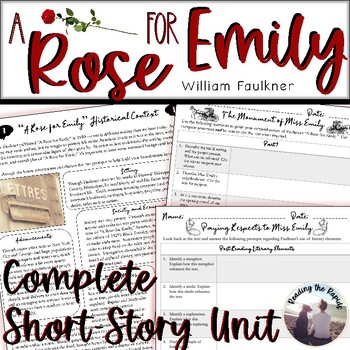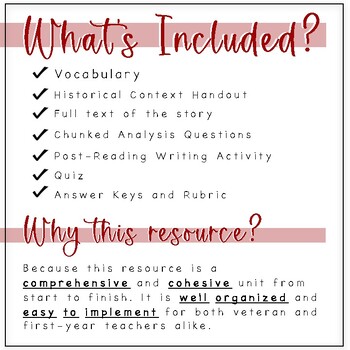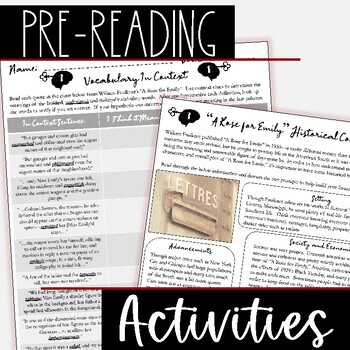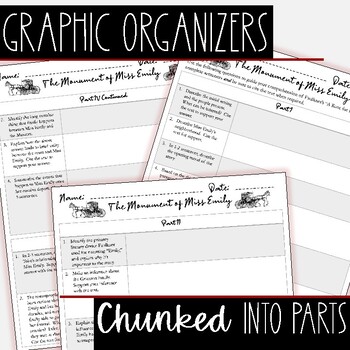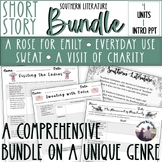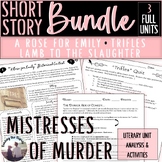William Faulkner A Rose for Emily Short Story Unit Questions Activities Quiz
- Zip
What educators are saying
Also included in
- This short story bundle includes lessons for A Rose for Emily by William Faulkner, Sweat by Zora Neale Hurston, Everyday Use by Alice Walker and A Visit of Charity by Eudora Welty. There is loads of analysis to be done, dialogue to be had, and inferences to be made with this bundle! I am confidentPrice $14.50Original Price $18.00Save $3.50
- This short story bundle contains three full units, each with a protagonist in desperate need of analysis, diagnosis and intervention! In this bundle for A Rose for Emily, Trifles and Lamb to the Slaughter, students will have the opportunity to analyze and interact with three murderous protagonists.Price $9.00Original Price $10.50Save $1.50
Description
William Faulkner's A Rose for Emily is a great short story lesson to use to discuss inferences, characterization, foreshadow, theme, point of view and more!
This short story analysis includes the following:
-Pre-reading vocabulary
-Historical context handout
-Analysis questions chunked by text parts
-Post-reading literary devices handout
-Post-reading writing activity
-Quiz
-Full text of the short story
-Answer key and rubric
**Please note: This lesson plan is a ZIP file with three PDFs; they are not editable. This is to help protect my work. If you are looking for something editable, this product does not give that capability. However, all PDFs can be used with distance learning, by using the mark up tools within the PDF.**
This short story lesson covers the following Common Core State Standards:
Key Ideas and Details:
CCSS.ELA-LITERACY.RL.11-12.1
Cite strong and thorough textual evidence to support analysis of what the text says explicitly as well as inferences drawn from the text, including determining where the text leaves matters uncertain.
CCSS.ELA-LITERACY.RL.11-12.2
Determine two or more themes or central ideas of a text and analyze their development over the course of the text, including how they interact and build on one another to produce a complex account; provide an objective summary of the text.
CCSS.ELA-LITERACY.RL.11-12.3
Analyze the impact of the author's choices regarding how to develop and relate elements of a story or drama (e.g., where a story is set, how the action is ordered, how the characters are introduced and developed).
Craft and Structure:
CCSS.ELA-LITERACY.RL.11-12.4
Determine the meaning of words and phrases as they are used in the text, including figurative and connotative meanings; analyze the impact of specific word choices on meaning and tone, including words with multiple meanings or language that is particularly fresh, engaging, or beautiful. (Include Shakespeare as well as other authors.)
CCSS.ELA-LITERACY.RL.11-12.6
Analyze a case in which grasping a point of view requires distinguishing what is directly stated in a text from what is really meant (e.g., satire, sarcasm, irony, or understatement).
Range of Reading and Level of Text Complexity:
CCSS.ELA-LITERACY.RL.11-12.10
By the end of grade 11, read and comprehend literature, including stories, dramas, and poems, in the grades 11-CCR text complexity band proficiently, with scaffolding as needed at the high end of the range.
Writing:
CCSS.ELA-LITERACY.W.11-12.3
Write narratives to develop real or imagined experiences or events using effective technique, well-chosen details, and well-structured event sequences.
CCSS.ELA-LITERACY.W.11-12.3.A
Engage and orient the reader by setting out a problem, situation, or observation and its significance, establishing one or multiple point(s) of view, and introducing a narrator and/or characters; create a smooth progression of experiences or events.
CCSS.ELA-LITERACY.W.11-12.4
Produce clear and coherent writing in which the development, organization, and style are appropriate to task, purpose, and audience. (Grade-specific expectations for writing types are defined in standards 1-3 above.)
Language:
CCSS.ELA-LITERACY.L.11-12.1
Demonstrate command of the conventions of standard English grammar and usage when writing or speaking
CCSS.ELA-LITERACY.L.11-12.2
Demonstrate command of the conventions of standard English capitalization, punctuation, and spelling when writing.
CCSS.ELA-LITERACY.L.11-12.4.C
Consult general and specialized reference materials (e.g., dictionaries, glossaries, thesauruses), both print and digital, to find the pronunciation of a word or determine or clarify its precise meaning, its part of speech, its etymology, or its standard usage.
Looking for a bundle? "A Rose for Emily" is included with "Sweat," "A Visit of Charity" and "Everyday Use" in my Southern Literature Bundle!
Additionally, "A Rose for Emily" is in my Mistresses of Murder Bundle with "Lamb to the Slaughter" and "Trifles!"
Keywords: A Rose for Emily, William Faulkner, short story unit

